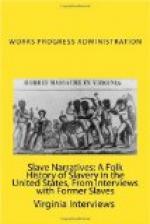Her husband went to the war to be “what you call a valet for Master Jim’s son, Sam”. After the war, he “came to me and my daughter”. “Then in July, we could tell by the crops and other things grown, old Master Jim told us everyone we was free, and that was almost a year after the other slaves on the other plantations around were freed”. She said Scott, in freeing (?) then said that “he didn’t have to give us any thing to eat and that he didn’t have to give us a place to stay, but we could stay and work for him and he would pay us. But we left that night and walked for miles through the rain to my husban’s brother and then told them that they all were free. Then we all came up to Kentucky in a wagon and lived there. Then I came up North when my husband died”.
Mrs. Richardson says that she is “so happy to know that I have lived to see the day when you young people can serve God without slipping around to serve him like we old folks had to do”. “You see that pencil that you have In your hand there, why, that would cost me my life ’if old Mas’ Jim would see me with a pencil in my hand. But I lived to see both him and Miss Elizabeth die a hard death. They both hated to die, although they belonged to church. Thank God for his mercy! Thank God!” “My mother prayed for me and I am praying for you young folks”.
Mrs. Richardson, despite her 90 years of age, can walk a distance of a mile and a half to her church.
Submitted August 31, 1937
Indianapolis, Indiana
Federal Writers’ Project
of the W.P.A.
District #6
Marion County
Anna Pritchett
1200 Kentucky Avenue
Folklore
Joe Robinson—ex-slave
1132 Cornell Avenue
Joe Robinson was born in Mason County, Kentucky in 1854.
His master, Gus Hargill, was very kind to him and all his slaves. He owned a large farm and raised every kind of vegetation. He always gave his slaves plenty to eat. They never had to steal food. He said his slaves had worked hard to permit him to have plenty, therefore they should have their share.
Joe, his mother, a brother, and a sister were all on the same plantation. They were never sold, lived with the same master until they were set free.
Joe’s father was owned by Rube Black, who was very cruel to his slaves, beat them severely for the least offense. One day he tried to beat Joe’s father, who was a large strong man; he resisted his master and tried to kill him. After that he never tried to whip him again. However, at the first opportunity, Rube sold him.
The Robinson family learned the father had been sold to someone down in Louisiana. They never heard from, or of him, again.
Interviewer’s Comment
Mr. Robinson lives with his wife; he receives a pension, which he said was barely enough for them to live on, and hoped it would be increased.




